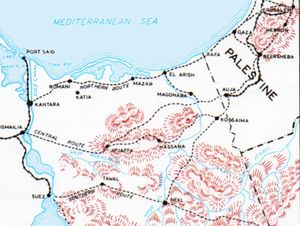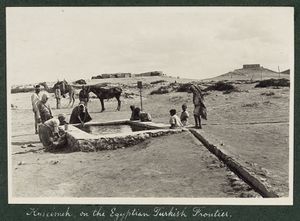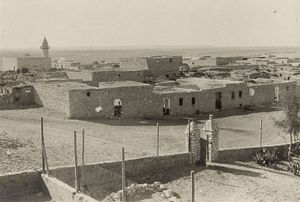الغارة على نخل
| الغارة على نخل | |||||||
|---|---|---|---|---|---|---|---|
| جزء من مسرح الشرق الأوسط في الحرب العالمية الأولى | |||||||
 خريطة شبه جزيرة سيناء. | |||||||
| |||||||
| المتحاربون | |||||||
|
|
بدو سيناء | ||||||
| القادة والزعماء | |||||||
|
| |||||||
| الوحدات المشاركة | |||||||
|
فوج الخيالة الخفيفة رقم 11 No. 9 Coy [لواء الهجانة الامبراطورية | |||||||
| القوى | |||||||
| 420 + و3 طائرات | 64 -130 حامية من العثمانيين والبدو | ||||||
| الضحايا والخسائر | |||||||
| لا أحد | 1 قتيل و11 أسير | ||||||
الغارة على نخل وقعت في فبراير 1917 بعد معركة رفح وقبل معركة غزة الأولى، أثناء حملة سيناء وفلسطين في الحرب العالمية الأولى. توغلت قوة التجريدة المصرية إلى وسط شبه جزيرة سيناء لمهاجمة وردع آخر حاميات الجيش العثماني إلى فلسطين.
كانت نخل مركز الادارة البريطانية في المنطقة حتى غزة القوات العثمانية المنطقة في بداية الحرب. أثناء الغارة على قناة السويس في فبراير 1915 تنقلت جزء من القوات المهاجمة عبر نخل.
في فبراير 1917 كانت الحاميات العثمانية الموجودة بالمنطقة خلف الخطوط الأمامية تماماً. باحتلال جنوب فلسطين بدأ مهاجمة تلك القوات المعزولة ودفعها للتراجع إلى فلسطين العثمانية.
خلفية
كان كلا الطريقين عبر العريش، والطريق المؤدي إلى قناة السويس من معان عن طريق نخل تحت حراسة السفن البريطانية الراسية على ساحل البحر المتوسط وخليج العقبة. كانت قوات كرس فون كرسنستاين التي هاجمت قناة السويسي في فبراير 1915 قد إنتقلت بمحاذاة الطريق المركزي عبر صحراء سيناء للاستفادة بالمياه الموجودة في القسيمة ونخل.[1] استمرت القوات العثمانية في احتلال جميع المناطق على الطريق المركزي عبر جنوب سيناء من القسيمة حتى قناة السويس، بما فيها نخل، التي كانت عبارة عن قرية صغيرة بها حوالي 50 منزل من اللبن والحجر، ومسجد وصحن. وكانت نخل تقع في منطقة تتميز بندرة المياه وصعوبة الطقس مما يجعل القتال فيها مستحيل على الطرفين، غير أنها كانت تشكل قاعدة أمامية عثمانية هامة تبعد 97 كم شرق السويس، تعزز السلطة العثمانية على العرب والبدو. عند بدء الحرب، كانت الادارة البريطانية تقع أيضاً في نخل.[2][3]
بداية الأحداث
أصدر الجنرال موراي أوامره بتحرك القوات المشاركة في حملة سيناء تاجه نخل وبئر الحسنة.[2] نصح قسم المخابرات التابع للقيادة العامة بعد الانسحاب من سيناء نتيجة لتقدم قوات التجريدة المصرية بمحاذاة الطريق الساحلي، وتم نشر 130 جندي في نخل. في 6 فبراير صدرت أوامر لفوج الخيالة الخفيفة رقم 11 الموجود في القطاع الجنوبية من القناة بالاستعداد لعمليات على نخل تشمل قطع الاتصالات بين نخل وبئر سبع.[1]اتجاه القسم الثاني من الفوج إلى المأدبة للوصول إلى بئر الحسنة على بعد 64 كم شمال نخل، بين جبل هلال وجبل يلج.[4]
Two mounted columns set out from the Suez Canal on 13 February 1917. Northern Column consisting of 420 troopers in the 11th Light Horse Regiment commanded by Lieutenant Colonel W. Grant, one Royal Engineer officer and four other ranks, one RAMC officer with a detachment of 124th Field Ambulance Str. 26, one RFC officer and two other ranks and two wireless pack stations, rode out from Serapeum near Ismailia in the centre of the Canal. They were accompanied by Lieutenant Colonel A. W. Jennings Bramly, Egyptian Government officer with knowledge of the country, Captain F. D. Stirling General Staff GHQ and Lieutenant A. H. Stuart Intelligence Branch, General Staff, along with one aircraft observer and two mechanics to choose advanced landing ground and supervise the transportation of petrol, oil and spare parts. By 14 February the column concentrated at Zogna where a supply dump had been established. Meanwhile Southern Column consisting of British Yeomanry and Indian units rode out from Suez at the southern end of the Suez Canal, via Heniak, Ayun Sudr, the Mitla Pass and the Darb el Haj towards Nekhl. Three aircraft from No. 1 Squadron based at El Arish worked from the aerodrome of No. 57 Reserve Squadron at Ismailia during the raid, were to report daily on the progress of the two columns, drop messages from headquarters and scout ahead. while a yeomanry force marched from Suez via the Mitla Pass and the Darb el Haj.[5][6][7]
Northern Column advanced to Bir el Giddi on 15 February were a detachment of 60 rifles from No. 9 Coy Imperial Camel Corps joined the column from Shallufa. Here an officer's patrol commanded by Lieutenant Farlow reported the Themada wells silted up and no water was available there. Instead of the proposed three nights, this information meant only two nights could be spent at an advanced base to be established near Nekhl.[8] As a result, a group was sent ahead by Northern Column to Themada to do their best to obtain a water supply, while that column followed from Bir el Giddi in cold and wet weather, after giving the horses time to get a good drink. On arrival at Themada four wells had been dug to an average of 8 أقدام (2.4 m), each of the wells had 4 أقدام (1.2 m) of water which was maintained during pumping water for the whole regiment. [9]
Major Bassett commanding 2nd Battalion (British) Imperial Camel Brigade marched from Magdhaba on 17 February to surround Bir el Hassana, where the Ottoman Army garrison reinforced by armed Bedouins was attacked at dawn the next morning. During the attack a severely wounded soldier was flown back to El Arish by aircraft. After the surrender of Bir el Hassana, Bassett's force remained in position to capture any Ottoman force withdrawing back from Nekhl towards Bir el Hassana.[10]
نخل
On 17 February Northern Column sent an officers' patrol commanded by Lieutenant F. C. Farlow to select a site for an advanced base and to reconnoitre the Thilwetl el Thamamat Pass, 4 ميل (6.4 km) north of Nekhl. The patrol reported at 15:30 that three shots had been fired from high ground on the Bir el Hassana road shortly after 13:00 by a Bedouin who subsequently withdrew on his camel towards Nekhl. By 16:00 Northern Column reached 7 ميل (11 km) north of Nekhl where an advanced base was established. [11]
The Farlow's patrol sent back a report which was received at 16:45 that the pass was unoccupied but that men could be seen withdrawing from Nekhl towards the east. Farlow requested support "as he was pushing on in pursuit" and 'B' Squadron 11th Light Horse Regiment rode out at 17:10. Meanwhile Farlow's patrol captured four hostile soldiers with ten camels but they were prevented from crossing the plain by rifle fire from about 50 hostile soldiers in the foothills where the Nekhl to Akaba road leaves the plain to the east of Nekhl. An aircraft which landed at Grant's advanced base shortly after 'B' Squadron left, was sent to reconnoitre Nekhl. It returned at 17:40 to report the town unoccupied and no sign of hostile soldiers on the roads to the east. 'B' Squadron, commanded by Captain C. A. R. Munro entered Nekhl at 19:45 "riding with fixed bayonets." Two Bedouin and one Ottoman soldier were captured in the town.[5][12] As it was dark further movement was impossible and the squadron bivouacked in the town with a defensive cordon while the plain was patrolled during the night. [12] All three aircraft landed at Bir el Themada where they camped with Northern Column during a very cold night.[7][Note 1]
During the evening of 17 February two prisoners disclosed that six Ottoman soldiers were expected to return that evening from Bir el Hassana with rations. A detachment of Imperial Camel Corps sent to intercept them, captured six camels with stores while the two bedouin driving the camels, escaped. [13]
At 04:00 on 18 February, the main force of Northern Column left their advanced base and entered Nekhl at 06:00 when two more prisoners and abandoned arms, ammunition and stores were captured. Patrols sent out eastwards up to a distance of 15 ميل (24 km) failed to find any hostile soldiers. Heliographic communication was established by Northern Column with Southern Column at 08:30; that column reaching Nekhl at 09:05. After a thorough search of the town and the demolishing of a captured field gun, Southern Column commenced their return journey at 10:30. Later another two Arab were found hiding in the hills along with one Ottoman soldiers who was killed while trying to escape.[14]
النتائج
Prisoners' statements reported Nekhl had been garrisoned by 40 armed Bedouin and 24 Ottoman soldiers, commanded by an Ottoman officer and an Arab Faud Effendi, both of whom escaped. Telegraph and telephone wires were cut and posts removed before Northern Column returned to their advanced base for the night. They began their journey back on the morning of 19 February travelling via Bir el Giddi where the Northern Column camped on 20 and 21 February.[15]
Southern and Northern Columns made the round trip of some 120 ميل (190 km) in harsh desert conditions.[2] Daily rations weighing 4 رطل (1.8 kg) and one gallon of water per man and 20 رطل (9.1 kg) of compressed fodder and six gallons per horse were transported by 1600 camels of 'N' and 'Q' Companies of the Camel Transport Corps commanded by Captain Swallow. The camels, practically all of which were Somalis worked well, covering more than 20 ميل (32 km) a day. Communications were maintained by the two wireless telegraph pack sections with Northern Column but communication with Southern Column was only by aircraft messages or visual signalling which was difficult in the country the two columns moved through.[16]
The aircraft kept contact with the two columns as they converged from the east and south on Nekhl, dropping messages from headquarters and scouting ahead when necessary. On 17 February when the columns were not far from Nekhl, air reconnaissance found the village abandoned and an extensive air reconnaissance the next day found no sign of the enemy in the area 17 ميل (27 km) beyond Nekhl.[3] However, late arrival of aircraft and engine trouble meant important messages to General Pitt were never delivered. Aerial reconnaissance also had difficulty finding small groups of troops, one aircraft failed to see the whole of Northern Column when it flew over.[17]
الهوامش
- ^ The airmen probably camped with Northern Column at the advanced base. [Grant p. 3]
المراجع
- ^ أ ب Falls 1930 Vol. 1 p. 35
- ^ أ ب ت Gullett 1941, p. 246
- ^ أ ب Cutlack 1941 pp. 53–5
- ^ Cutlack 1941 p. 53
- ^ أ ب Gullett 1941 p. 247
- ^ خطأ استشهاد: وسم
<ref>غير صحيح؛ لا نص تم توفيره للمراجع المسماةAnzacMDwdA118p1 - ^ أ ب Cutlack 1941 p. 54
- ^ Grant pp. 1–2, 6
- ^ Grant p. 2
- ^ Gullett 1941 pp. 246–7
- ^ Grant pp. 2–3, 6
- ^ أ ب Grant p. 3
- ^ Grant p. 4
- ^ Grant pp. 3–4
- ^ Grant pp. 4–5
- ^ Grant pp. 5–6
- ^ Grant p. 6
المصادر
- First World War Diaries AWM4 1/60, General Staff, Headquarters Anzac Mounted Division, Canberra: Australian War Memorial, May 1917, http://www.awm.gov.au/collection/war_diaries/first_world_war/subclass.asp?levelID=1338
- Grant, Lieutenant Colonel W (May 1917), "Appendix 118: Report on Operations against Nekhl", Canberra: Australian War Memorial, http://www.awm.gov.au/collection/records/awm4/1/60/awm4-1-60-15part1.pdf#page=60
- F. M. Cutlack (1941). "The Australian Flying Corps in the Western and Eastern Theatres of War, 1914–1918". Official History of Australia in the War of 1914–1918 Volume VIII (11th ed.). Canberra: Australian War Memorial.
- Falls, Cyril (1930). Military Operations Egypt & Palestine from the outbreak of war with Germany to June 1917. Official History of the Great War Based on Official Documents by Direction of the Historical Section of the Committee of Imperial Defence. Vol. 1. London: HM Stationary Office. OCLC 610273484.
{{cite book}}: Unknown parameter|coauthors=ignored (|author=suggested) (help) - Gullett, H.S. (1941). The Australian Imperial Force in Sinai and Palestine, 1914–1918. Official History of Australian in the War of 1914–1918, Volume VII. Canberra: Australian War Memorial. OCLC 220900153.
- CS1 errors: unsupported parameter
- نزاعات 1917
- 1917 في مصر
- الدولة العثمانية في الحرب العالمية الأولى
- الامبراطورية البريطانية في الحرب العالمية الأولى
- مصر في الحرب العالمية الأولى
- مسرح عمليات الشرق الأوسط في الحرب العالمية الأولى
- حملات ومسارح عمليات الحرب العالمية الأولى
- حملات عسكرية ومسارح عمليات أستراليا في الحرب العالمية الأولى
- معارك حملة سيناء وفلسطين
- معارك المملكة المتحدة في الحرب العالمية الأولى
- معارك الحرب العالمية الأولى التي شاركت فيها الهند البريطانية
- معارك الحرب العالمية الأولى التي شاركت فيها الدولة العثمانية
- معارك أستراليا في الحرب العالمية الأولى


